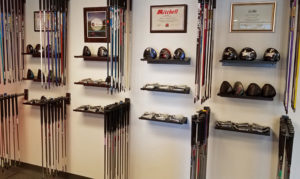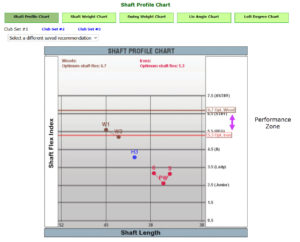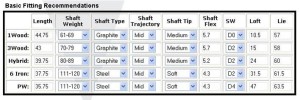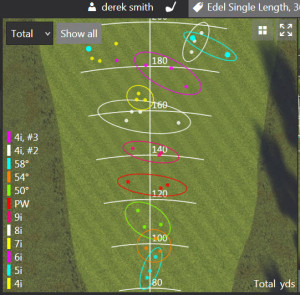What should you expect in an iron fitting? Gone are the days of going in to your pro shop or golf store and testing a few different models available. Here are the days of getting custom fit for literally any combination of heads and shafts. I am talking about a true custom fitting, not just getting fit to the best irons the pro shop has in stock or in their demo system. In a professional iron fitting, the results should be a 50% reduction in shot dispersion and a 5-10% improvement in distance over your current set.
Here is what you should expect:
- Player Interview…What are you looking to accomplish?
- What is the Performance of your Existing set?
- Get launch monitor data from your existing 6 or 7 iron.
- Have the fitting system recommend shafts.
- Pick 3-4 heads to try.
- Use launch monitor to determine the best combination.
- Have the option to re-shaft existing equipment.
- Choose the option that gives you optimized performance!
Player Interview – What are you looking for?
A good custom fitting for irons starts with an interview of what you want to accomplish with your new set, i.e. distance accuracy or consistency. Then, the fitter should look at your current equipment and ask you specific questions about your distances, miss-hits, trajectory and ball flight.
Then, your fitter should ask you what particular irons you have been thinking about so you can choose three or four different heads to test. If you love your current irons but are not sure the shafts fit you properly, re-shafting your existing set should be another option. The fitter may ask you if you prefer steel or graphite as you may have a particular reason for playing graphite (tendonitis, arthritis) or steel.
What is the performance of your existing set?
Now the fun begins. Your fitter should have you warm up and then get your launch monitor numbers, i.e. club speed, ball speed, launch angle, spin rate, attack angle and shot dispersion at a minimum. Your fitter should also measure your tempo, transition and release points to help determine which shaft characteristics may work the best to optimize launch, spin and shot dispersion.
Have the fitting system recommend shafts
The best fitters will take this information, put it in their fitting system and have the system recommend a particular club length, shaft weight, shaft flex, swing weight and shaft profile.
With this information, your fitter will then select three or four shafts that meet these criteria and assemble them with a universal connection system to one of the heads you have selected. We literally have tens of thousands of combinations of heads and shafts but narrow it down to the best three or four heads and shafts. We fit irons by using a single head with multiple shafts until we get the best performance in terms of both distance and accuracy. Then we try different heads with the idea of again getting the best performance. Your job during this entire process is to give your fitter feedback as to which combination of heads and shafts looks, sounds and feels the best. During this process, your fitter will also be determining the proper length and lie angle with the optimized shaft and head combination.
You Make the Decision – New or Re-Shaft
We can usually test your existing brand and model of head to see if it may be just the shaft and grip that need changing to improve performance. If your current set is only 2-3 years old, you may find acceptable performance with only a re-shaft of your existing irons. But make no mistake, some of the new technology is truly amazing in terms of distance, accuracy and consistency improvement.
The result of your fitting is to give you improved performance over your existing set of irons. We typically see a 50% reduction in shot dispersion and 5-10% increase in distance. If we do not improve your existing performance we have not done our job as a fitter.
Dan Sueltz




